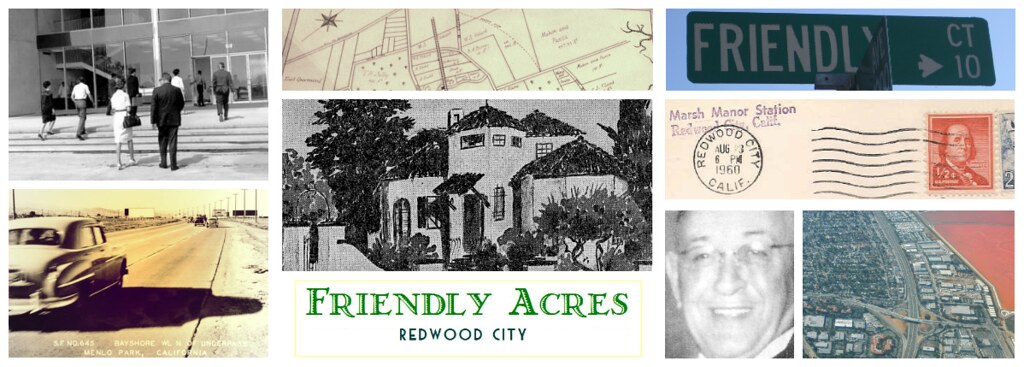Settlers of a new community: Friendly Acres
It is April 1945 and America doesn't yet know it, but it is only days away from the monumental German surrender in the European theater of WW II. A class of teenagers at Sequoia Union High in Redwood City, CA, have been assigned a special project: to transcribe interviews with notable founders of their respective neighborhoods and communities. Two of the students, Irene Winnick and Jeanette Giovannoni go home to Friendly Acres and interview their families and local merchants.What follows in this post, is a transcription of Irene Winnick's homework assignment. Her original work, along with Jeanette's and other Sequoia students involved with this Oral History project are housed and may be viewed, with permission, at the Redwood City Archives.
~*~*~*~*~*~*~*~*~*~
Irene Winnick, US History. April 12, 1945. Period II. Sequoia Union High School
Friendly Acres is a section situated between Redwood City and Menlo Park. Although this community is not very well known or large in size, it is fast becoming a large community. Friendly Acres was started in the year 1930 by a man named Friend. He was driving down the Bayshore Highway and, even though, covered with pasture lands and cattle all over, he saw in this land a future community.
In about one year both Mr. Friend and his wife built their home, soon their friends came down and one of their best friends, lawyer in San Francisco, built a large summer home for his family. Then came a Real Estate office, under the ownership of an able man, named L.W. Billings. He brought with him the hopes of the average working man to build a home of his own, and soon the empty little streets were being filled up!
Mr. Friend realized that the people needed a store or some sort of place in which to supply their every day food and transportation commodities, so together with an old business acquaintance he formed the "Friendly Auto Court”, which gave a place for a quick pickup of food, chance to re-fuel, as a place for a weary traveler to rest. So after that the “Virginia Reed Auto Court”, was formed by some of the people of Friendly Acres themselves.
In 1938, Mr. Friend built a new Home on the Old Marsh Road, in order to stretch out the community, but because of ill health on the part of Mrs. Friend, they were forced to move back to San Francisco, but now they live in the San Carlos hills, were the climate is higher and dryer. Mr. and Mrs. Friend will be longed rembered for their generous behavior to their friends and neighbors, and remembered as the,“Settlers of a New Community.”
Friendly Acres had a boom in the year, 1939, for then a store and service station were added to the already growing community. The store was named “Friendly Food Shop” and the station was started by the Shell Company, with an owner who lived in Friendly Acres as did the store owner. Soon many people who drove down the Bayshore Highway, took more than one passing glimpse, and soon talked to the people and then built their homes. Friendly Acres was growing up.
After war was declared and the Red Feather and National Motor Bearing were built, many people flocked to Friendly Acres and bought the home built by outstanding contractors; one of whom was J.P. Goodenuff. Then the government built (20) twenty each different in planning, on several blocks numbering three. For a while Friendly Acres was a place of unsettled people who were moving in and out and now it is a place of settled and contented homes.
Friendly Acres is the example of the American home front, small in size, yet powerful in deeds. Soon after victory it will grow and its people will have churches, schools, and perhaps try again to become a part of Redwood City, which has been tried and hoped for many times, but with know [sic] success.
Attained information:Mr. P.S. Constanta, 460 Hoover St. Redwood City;
and Mr. P. Giovannoni, Friendly Food Shop, Bayshore Highway
This letter naturally triggered a slew of other questions for me and became the impetus for this blog. As to Jeanette's work, I haven't forgotten about her, in case you were wondering - will get around to sharing her oral transcript homework in another post later.
~*~*~*~*~*~*~*~*~*~
Post Script: A small but poignant detail about this assignment is the date when it was written - April 12, 1945. Despite the tone of hopeful bravado it ends on, radio broadcasts were to announce that evening that the country's longest serving President, Franklin Delano Roosevelt, had just died of a cerebral hemorrhage, three months into his fourth term in office. The nation went into mourning for the man who had led them out of the Great Depression and through the second world war.










1 comments:
Write commentsMy name is Jeff Taylor. Irene was my mother. My grandparents home, built in 1938 I believe, at 3150 Hoover St, was across the street from the Friend's large home. Years later I lived at 17th and Hoover for a few years from.'82 to '85.
Reply